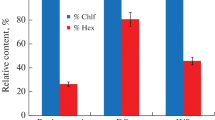Abstract
A gravimetric method to determine heavy fractions of total petroleum hydrocarbons (TPH) in soils is reported. The method was adapted and calibrated by modifying previous standard methods published, incorporating energy and cost savings where possible. Artificially contaminated soils with different organic matter content, and aged in stationary mode for a period of 8 months were used for calibration. Insufficient solvent evaporation was identified as the most prevalent and largest positive interference in the gravimetric detection. To overcome this, while minimizing the need for heating, a combination of three 10-min rotary evaporator steps and 30 min of vacuum in a desiccator were applied, for a total solvent volume of 60 ml. Hexane was chosen as the extraction solvent and a 40–60 min treatment in an ultrasound bath of 260 W was found suitable to extract 80–95% of TPH extracted by the Soxhlet method. Finally, the use of silica gel for cleanup of co-extracted natural organic matter was found unnecessary, because of the low amounts co-extracted for soils with up to 5% organic carbon, and because the chemical nature of the co-extracted organic matter prevents its selective adsorption to silica.



Similar content being viewed by others
References
Aguirre, A., León, F., & Aguilar, A. (2002). Estudios de optimización de la oxidación crómica del carbono orgánico de los suelos. Terra, 21, 21–30.
Arce, J. M. (2000). Inducción de la biodegradación de hidrocarburos policíclicos aromáticos en un suelo contaminado artificialmente. Dissertation, UNAM.
BAM (2000). Calibration Standard—SET for the determination of mineral oil hydrocarbons in environmental matrices by means of gas chromatography: BAN KS 5004 Diesel Fuel/Lubricatin Oil (1:1). (Berlin: Bundesanstalt für Materialforschung und-prüfung, Division 1.2.)
BAM (2002). Certificate of reference material BAM UO13, Polyciclic aromatic hydrocarbons (PAH) in soil. (Berlin: Bundesanstalt für Materialforschung und-prüfung, Division 1.2).
CMECC (California Military Environmental Coordination Committee). (1996). Field analytical measurement technologies, applications, and selection. Chemical Data Quality/Cost Reduction Process Action Team. Available at: http://www.epa.gov/Region9/qu/pdfs/measure-technol.pdf.
EPA Method 1664 A. (1999). n-Hexane extractable material (HEM; oil & grease) and silica gel treated n-hexane extractable material (SGT-HEM, non-polar material) by extraction and gravimetry. Washington, DC: United States Environmental Protection Agency, Office of Water, EPA-821-R-98-002.
EPA Method 3550 B (1996). Ultrasonic extraction. United States Environmental Protection Agency, SW-846 Manual. Washington, DC: U.S Government Printing Office.
EPA Method 3630 B (1996). Silica gel cleanup. United States Environmental Protection Agency, SW-846 Manual. Washington, DC: US Government Printing Office.
EPA Method 4030 (1996). Soil screening for petroleum hydrocarbons by Immunoassay. United States Environmental Protection Agency, SW-846 Manual. Washington, DC: U.S Government Printing Office.
EPA Method 8015 C. (2000). Nonhalogenated Organics using GC/FID. United States Environmental Protection Agency, SW-846 Manual. Washington, DC: US Government Printing Office.
EPA Method 8440. (1996). Total recoverable petroleum hydrocarbons by infrared spectrophotometry. United States Environmental Protection Agency, SW-846 Manual. Washington, DC: US Government Printing Office.
EPA Method 9071 B. (1998). n-Hexane extractable material (HEM) for sludge, sediment, and solid samples. United States Environmental Protection Agency, SW-846 Manual. Washington, DC: US Government Printing Office.
Essington, M. E. (2004). Soil and water chemistry: An integrative approach. Boca Raton, Florida: CRC.
Langmuir, D. (1997). Aqueous environmental geochemistry. Upper Saddle River, New Jersey: Prentice Hall.
Massachusetts Department of Environmental Protection (MDEP). (1994). Interim final petroleum report: Development of health-based alternative to the total petroleum hydrocarbon (TPH) parameter. Boston, Massachusetts.
NMX-AA-134-SCFI-2006 (2006). Suelos–Hidrocarburos Fracción Pesada por Extracción y Gravimetría–Método de Prueba. Mexico: Diario Oficial de la Federación el 12 de Septiembre de 2006.
Schwab, A., Su, J., Wetzel, S., Pekarek, S., & Banks, M. (1999). Extraction of petroleum hydrocarbons from soil by mechanical shaking. Environmental Science & Technology, 33, 1940.
VRAI (Validation of RaPID AssayÒImmunoassay). (2007). TPH test Kits against Standard DFG Laboratory Techniques-Final Report for FY 2005–2006 Work. http://www.dfg.ca.gov/ospr/report/ssep/final_reports/final_report_bruce_joab_3–2007_rev.3_.pdf.
Weisman, W. (Ed). (1998). Analysis of petroleum hydrocarbons in environmental media. vol. 1. Prepared by Total Petroleum Hydrocarbon Criteria Working Group. Air Force Research Laboratory, Operational Toxicology Branch. Amherst: Amherst Scientific Publishers.
Xie, G. B., Barcelona, M. J., & Fang, J. S. (1999). Quantification and interpretation of total petroleum hydrocarbons in sediment samples by a GC/MS method and comparison with EPA 418.1 and a rapid field method. Analytical Chemistry, 71, 1899–1904.
Acknowledgements
The authors are grateful to: Dr. Arturo Aguirre Gómez from the Department of Chemistry at FES-Cuautitlán, UNAM for supplying the soils of study, for the pH and electric conductivity data for these, and for his assistance in the organic carbon determinations; Dr. Rutilio Ortiz, Geography Institute, UNAM, for supplying the high organic matter content soils, and for the pH and organic carbon data for these; Rosaura Paez, Geography Institute, UNAM, Morelia Unit, for help in acquiring the gas chromatograms; Ricardo Alfaro, Chemistry Institute, UNAM, for his assistance in the initial methods development; and two anonymous reviewers who helped improve considerably the legibility of the manuscript.
Author information
Authors and Affiliations
Corresponding author
Rights and permissions
About this article
Cite this article
Villalobos, M., Avila-Forcada, A.P. & Gutierrez-Ruiz, M.E. An Improved Gravimetric Method to Determine Total Petroleum Hydrocarbons in Contaminated Soils. Water Air Soil Pollut 194, 151–161 (2008). https://doi.org/10.1007/s11270-008-9704-1
Received:
Accepted:
Published:
Issue Date:
DOI: https://doi.org/10.1007/s11270-008-9704-1




